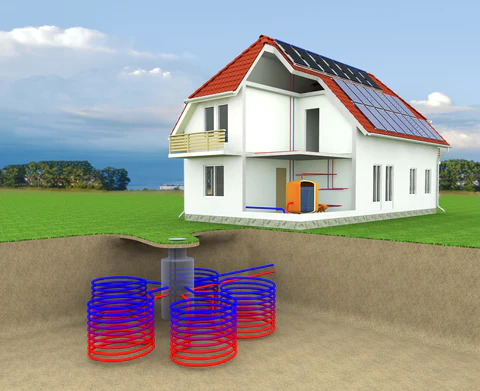Ground and Air Heat Pump
Ground-Source Heat Pump: Comprehensive Guide
Are you considering a more sustainable and environmentally friendly way to heat your home while reducing your ecological footprint? If so, a ground-source heat pump (GWHP) could be the ideal solution. Ground-source heat pumps are energy-efficient systems that provide heating and hot water for both residential and commercial properties by harnessing the natural heat from the earth. In this comprehensive guide, we will cover everything you need to know about ground-source heat pumps in 15 points.
What is a Ground-Source Heat Pump?
A ground-source heat pump is an innovative heating and hot water system that extracts heat from the earth and converts it into usable energy. It is a sustainable and renewable source of heating, making it an excellent choice for those seeking alternative energy solutions. GWHPs are particularly beneficial for homes not connected to the main grid, offering a greener and more environmentally friendly heating option.
How Does a Ground-Source Heat Pump Work?
The operation of a ground-source heat pump is straightforward. It utilizes the stored heat energy from the earth, originating from underground rocks and soil, and elevates it to higher temperatures suitable for space heating and hot water. This process is achieved through a network of pipes and heat exchangers.
There are two common types of GWHP collection systems: horizontal and vertical. Horizontal systems involve shallow trenches, while vertical systems require deep boreholes. The choice between these systems depends on available space and budget constraints.
In both systems, loops of pipes are installed underground, containing a heat transfer fluid that absorbs low-grade heat from the earth. This warmed fluid is then pumped through a heat exchanger inside the heat pump, where it is compressed to significantly higher temperatures. The resulting usable heat is transferred to the building's heating and hot water system. The cooled fluid is circulated again through the pipes, creating a continuous flow of energy.
The heat pump unit itself is typically installed above ground, similar in size to a small refrigerator. It requires a modest amount of space, usually housed in a utility room within the building. The pump is powered by electricity, which can come from a renewable energy supplier for a fully green energy solution. Ground-source heat pumps are particularly suitable for underfloor heating systems, as they operate efficiently at lower temperatures across larger areas.
Additionally, GWHPs often feature weather compensation technology, allowing them to adapt to changing weather conditions. This ensures optimal energy efficiency throughout the year, reducing energy waste and saving you money.
What Are the Benefits of a Ground-Source Heat Pump?
GWHPs offer a wide range of benefits for both homeowners and the environment:
- Reduced Carbon Footprint: Ground-source heat pumps have the lowest carbon dioxide emissions of any heating system compared to traditional options such as natural gas, LPG, oil, coal-fired boilers, or direct electric heating.
- Lower Energy Bills: Heating and hot water costs typically constitute a significant portion of household energy bills. A well-designed and properly installed GWHP system can lead to significant savings, especially compared to oil, LPG, and direct electric heating.
- Safe Operation: Since GWHPs do not burn fossil fuels, there is no risk of carbon monoxide poisoning, making them a safer choice for your family.
- High Energy Efficiency: GWHPs can achieve efficiency levels up to 400%, meaning they produce four times more energy than they consume. This efficiency level surpasses even the best new gas-fired boilers, which typically operate at around 90%.
- Long Lifespan: With proper maintenance and service, a ground-source heat pump can last up to 20 years, significantly longer than traditional boilers that often need replacement after 8-10 years.
- User-Friendly: GWHPs often feature weather compensation, allowing them to automatically adjust to changing temperatures. Moreover, you can control them via your smartphone for convenience and flexibility.
- Financial Support: Government incentive programs, such as the Boiler Upgrade Scheme (BUS) and the Home Energy Scotland Loan, provide financial assistance and cashback options to help offset installation costs.






